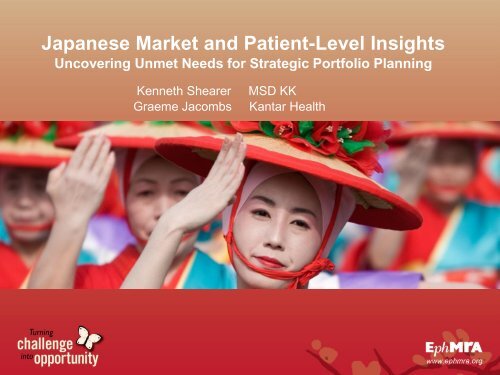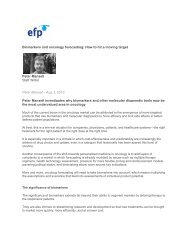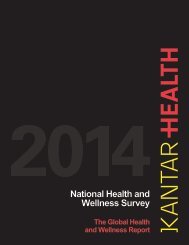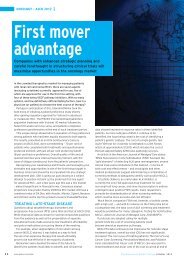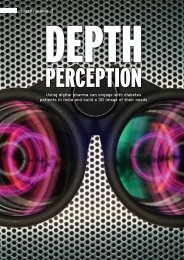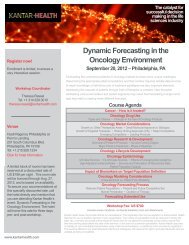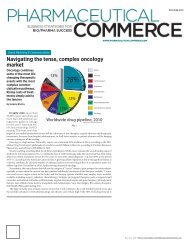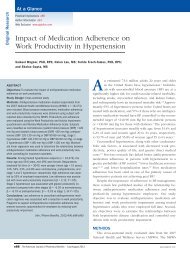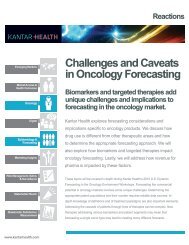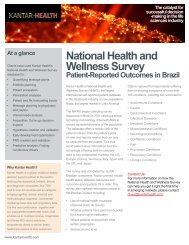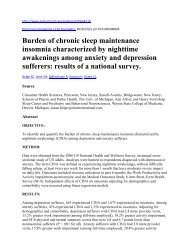full presentation - Kantar Health
full presentation - Kantar Health
full presentation - Kantar Health
You also want an ePaper? Increase the reach of your titles
YUMPU automatically turns print PDFs into web optimized ePapers that Google loves.
Japanese Market and Patient-Level InsightsUncovering Unmet Needs for Strategic Portfolio PlanningKenneth ShearerGraeme JacombsMSD KK<strong>Kantar</strong> <strong>Health</strong>
The ChallengeIdentify Japanese market and patient level insightsbased on unmet needs – comparing vs. other majorgeographic marketsIdentify demographic trends and comparisons inhealth habits and attitudes of Japanese citizens vs.citizens of other countriesMap MSD pipeline against future demographics,identify therapeutic areas of potential commercialinterest to MSD in the future
OutlineUnderstandingUnmet Needs:An InternationalComparisonUnderstandingUnmet Needs:A More MSDFocused ReviewSummary ofInsights andStrategicDirectionAn InternationalRanking andComparison ofConditionsSetting DirectionThrough PortfolioAnalysis2
Project Insight SourcesThe National <strong>Health</strong> and Wellness Survey (NHWS) DatabaseCovering 10 Markets with over 1 million respondents: US, 5 EU, Japan, China,Brazil & RussiaThe largest healthcare database of projectable, self-reported, “real world” patientlevel information which covers over 165 therapeutic conditionsThe Epi DatabaseCovering 13 Markets: US, 5 EU, Japan, Brazil, China, India, Mexico, Russia andTurkeyEpidemiology data covering up to 190 indications and projections3
UnderstandingUnmet Needs:An InternationalComparison
Unmet Needs among Most Prevalent ConditionsUnited StatesQuality of life (SF-6D scores)0.78Global meanlevel ofhealth utilityscoresHeadache/migraine HeartburnAllergy/hay feverArthritisDyslipidemiaHypertensionInsomnia/sleepdifficultiesPainAnxiety0.58DepressionPercentage currently treatedThe size of each bubble refers to the number of people who reported experiencing the given condition.
Quality of life (SF-6D scores)0.78Unmet Needs among Most Prevalent ConditionsBig 5 EU (France, Germany, Italy, Spain & the UK)Global meanlevel ofhealth utilityscoresAnginaHeadache/migraineHeartburnAllergy/hay feverDyslipidemiaInsomnia/sleepdifficultiesPainHypertensionAnxiety0.58DepressionPercentage currently treatedThe size of each bubble refers to the number of people who reported experiencing the given condition.
Unmet Needs among Most Prevalent ConditionsUrban ChinaQuality of life (SF-6D scores)0.78Global meanlevel ofhealth utilityscoresInsomnia/sleepdifficultiesHeadache/migrainePainArthritisAllergy/hay feverDermatitisHypertensionAnxietyAnemiaArrythmia0.58Percentage currently treatedThe size of each bubble refers to the number of people who reported experiencing the given condition.
Unmet Needs among Most Prevalent ConditionsJapanQuality of life (SF-6D scores)0.78Global meanlevel ofhealth utilityscoresHeartburnHeadache/migraineAllergy/hay feverPainArrythmiaArthritisEczemaDyslipidemiaHypertensionInsomnia/sleepdifficulties0.58Percentage currently treatedThe size of each bubble refers to the number of people who reported experiencing the given condition.
An InternationalRankingAnd Comparisonof Conditions
13Whileof the top20conditions are1consistent across geographies…1Ranked in order based on prevalence, source: The National <strong>Health</strong> and Wellness Survey databaseHeadacheHay FeverAbdominal PainMigraineHigh Blood PressurePainHeartburnHigh CholesterolGingivitisNasal AllergiesArthritisInsomniaArrhythmiaEczemaAbdominal BloatingDermatitisDiarrheaDry EyeChronic ConstipationDiabetes
95%of the conditions have a change inpriority order across geographiesand more than1/3of the conditions are different inJapan vs. US and EuropeHeadacheHay FeverAbdominal PainMigraineHigh Blood PressurePainHeartburnHigh CholesterolGingivitisNasal AllergiesArthritisInsomniaArrhythmiaEczemaAbdominal BloatingDermatitisDiarrheaDry EyeChronic ConstipationDiabetesJapan, priority change vsUS 5EUNochange
While many of theconditions thatdifferentiate Japanfrom the US andEurope, also feature inChinaChina, not JapanAnxietyAnemiaUlcer DiseaseFungal InfectionsOsteoporosisSleep DifficultiesHeadacheHay FeverAbdominal PainMigraineHigh Blood PressurePainHeartburnHigh CholesterolGingivitisNasal AllergiesArthritisInsomniaArrhythmiaEczemaAbdominal BloatingDermatitisDiarrheaDry EyeChronic ConstipationBoth Japan andDiabetesChinaJapan onlySimilar vs US and/or 5EU
UnderstandingUnmet Needs:A More MSDFocused Review
Unmet needs in Japan: A More MSD Focused ReviewFocusing on Quality of LifeQuality of life(SF-6D scores)average healthutility index for theall Japanese adults0.76SmokingCessationArthritisMigraineEczema2010HCVPsoriasisCOPDHigh CholesterolNasalAllergiesDiabetes HypertensionGlaucomaOsteoporosisAsthmaOABIBSInsomniaAnxietyBipolarDepression0.56Percentage currently treatedThe size of the bubbles represent the prevalence of experiencing the condition.The select conditions’ growth rates are excerpts from the <strong>Kantar</strong> <strong>Health</strong> Epi Database®
Unmet needs in Japan: A More MSD Focused ReviewFocusing on Quality of LifeQuality of life(SF-6D scores)average healthutility index for theall Japanese adults2015Diabetes+ 5.1%Hypertension+ 4.6%0.76Arthritis+ 5.9%Glaucoma+ 6.2%COPD+ 4.7%Osteoporosis+ 11.2%0.56Percentage currently treatedThe size of the bubbles represent the prevalence of experiencing the condition.The select conditions’ growth rates are excerpts from the <strong>Kantar</strong> <strong>Health</strong> Epi Database®
Unmet needs in Japan: A More MSD Focused ReviewFocusing on Quality of LifeQuality of life(SF-6D scores)average healthutility index for theall Japanese adults0.76Arthritis+ 10.1%2020Diabetes+ 8.6%Hypertension+ 7.6%Glaucoma+ 12%COPD+ 6.5%Osteoporosis+ 21.7%0.56Percentage currently treatedThe size of the bubbles represent the prevalence of experiencing the condition.The select conditions’ growth rates are excerpts from the <strong>Kantar</strong> <strong>Health</strong> Epi Database®
Unmet needs in Japan: A More MSD Focused ReviewFocusing on Work ImpairmentPercentage of overallwork impairment201050%InsomniaAnxietyBipolarDepressionIBSCOPDSmokingcessationAsthmaPsoriasisArthritisMigraineHCVEczemaNasal allergiesOsteoporosisDiabetesGlaucomaHigh cholesterolOABHypertension0%Percentage currently treatedThe size of the bubbles represent the prevalence of experiencing the condition.
Unmet needs in Japan: A More MSD Focused ReviewFocusing on HospitalizationsNumber ofhospitalizations inthe past six months4.002010COPDSmokingcessationArthritisIBSHCVInsomniaAnxietyOsteoporosisBipolarDepressionGlaucomaDiabetesHypertension0.00MigraineEczemaPsoriasisNasal allergiesAsthmaHighcholesterolPercentage currently treatedOABThe size of the bubbles represent the prevalence of experiencing the condition.
AsthmaBipolar disorderHypertensionCOPDSleep difficultiesMigraineAnxietyDiabetesHigh cholesterolDepressionIBSGlaucomaOsteoporosisOABSmoking cessationPsoriasisUnmet needs in Japan: A More MSD Focused ReviewFocusing on Patient Satisfaction20100.60Conditions with belowaverage satisfaction-0.60X-axis represents average medication satisfaction.19
Relative treatment satisfactionUnmet needs in Japan: A More MSD Focused ReviewFocusing on Patient SatisfactionHigh satisfaction, lowprevalence0.60Asthma2010High satisfaction, highprevalenceBipolardisorderCOPDAnxiety0% 2% 4% 6% 8% 10% 12% 14% 16% 18%IBSGlaucomaOsteoporosisDiabetesInsomniaDepressionHighcholesterolHypertensionMigraineOAB-0.60PsoriasisSmokingcessationPrevalence Percentage20
Relative treatment satisfactionUnmet needs in Japan: A More MSD Focused ReviewFocusing on Patient SatisfactionHigh satisfaction, lowprevalence0.60Asthma2020High satisfaction, highprevalenceBipolardisorderCOPDAnxiety0% 2% 4% 6% 8% 10% 12% 14% 16% 18%IBSGlaucomaOsteoporosisDiabetesInsomniaDepressionHighcholesterolHypertensionMigraineOAB-0.60PsoriasisSmokingcessationPrevalence Percentage21
Setting DirectionthroughPortfolioAnalysis
Potential Metrics to be consideredSize of opportunity• Epidemiology• Demographic change• % Treated / UntreatedPosition of company• Breadth of therapeutic coverage• Share of individual market (value / PDOT)• Perception of company within therapy area• Pipeline strengthUnmet Needs / Other• Humanistic (indirect) costs: QoL / Degree of Work Productivity and Activity Impairment• Direct Costs: Hospitalization, Dr. visits and ER• Further unmet needs• Treatment satisfaction
UnattractiveAttractive NeutralStrategy Assessment Cube• Approx. allocation ratiosUUUNUUUUNNUNAUUAUNUUA NUA AUAANNANUSize5 year CAGRAbsolute size% ChgUNA NNA ANAAANAAUUAA NAA AAAUnattractiveNeutralAttractivePosition of Company
Segment MappingsEach segments is mapped to a specific strategic directionSegmentDecisionSegmentDecisionSegmentDecisionAAANAAUAAAANNANUANAAUNAUUAUANANNAUNAANNNNNUNNANUNNUUNUAUANUAUUAAUNNUNUUNAUUNUUUUU
Summary ofInsightsand StrategicDirection
Summary of InsightsUnderstanding Unmet Needs: AnInternational ComparisonAn International Ranking andComparison of ConditionsAmong the most prevalentconditions globally, thereappears to be greaterunmet needs in emergingmarkets (China, etc.)While some conditions aresimilar across geographies,almost all change inprevalence rank order andJapan & China shareunique similaritiesUnderstanding Unmet Needs: Amore MSD focused ReviewMany further unmet needsare uncovered whenanalyzing from additionalperspectives: Humanistic /QoL (indirect), Direct Costs& SatisfactionSetting Direction throughPortfolio AnalysisIt is important to usemultiple perspectives to beable to identify hiddenunmet needs and matchthem with the strategicdirection of the company
Japanese Market and Patient-Level InsightsUncovering Unmet Needs for Strategic Portfolio PlanningKenneth ShearerGraeme JacombsMSD KK<strong>Kantar</strong> <strong>Health</strong>


